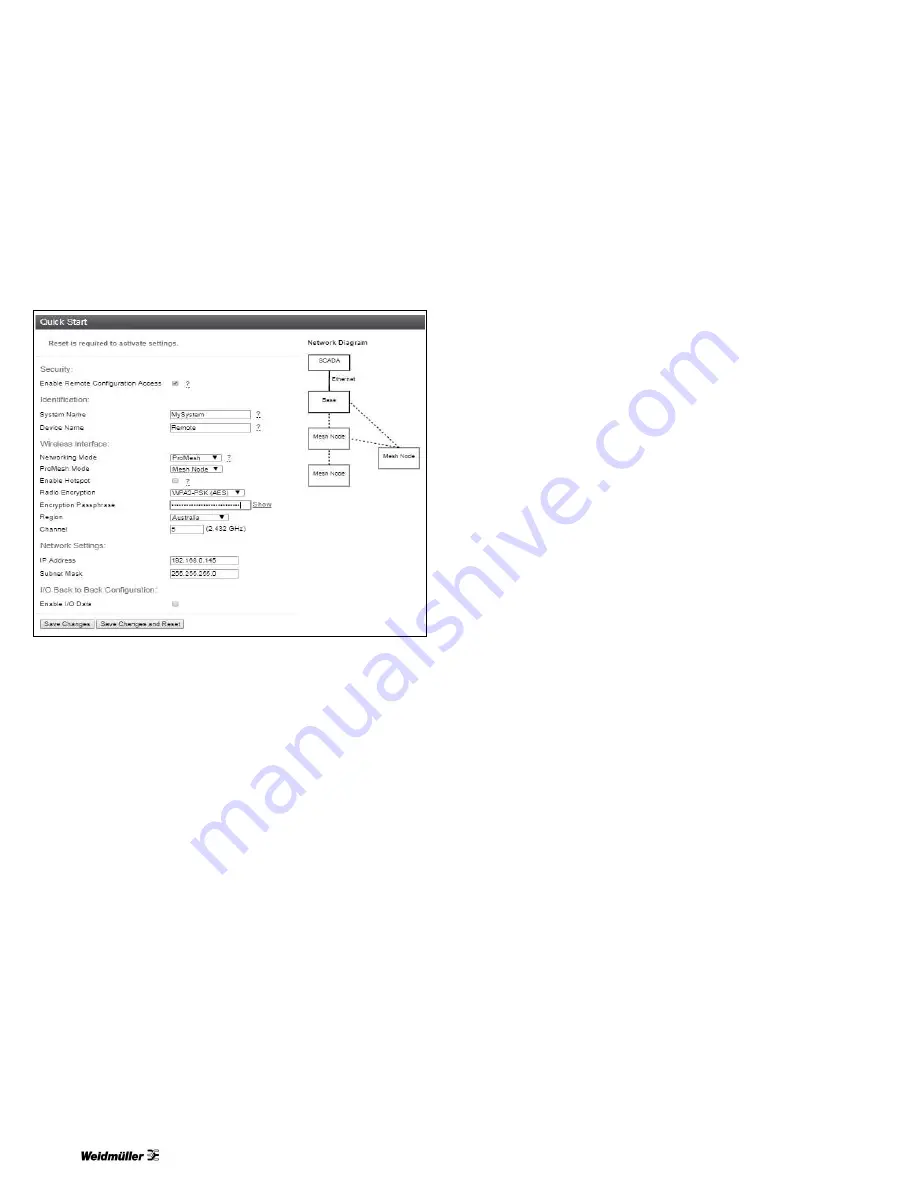
2
Quick Start Guide
WI-I/O-2-E-N-GBL
WI-I/O-2-E-N-GBL 802.11 Wireless I/
O and Gateway
www.weidmuller.com
Device Security
The WI-I/O-2-E-N-GBL supports industrial protocols such as Modbus and
WIB that do not provide encryption or authentication. These protocols are
convenient to use as they are widely known and supported by an extensive
range of equipment.
The downside of using these protocols is that they are also vulnerable to a
variety of cyber-attacks, so you must consider the security of the networks
that they operate over.
Quick Start Configuration
Access the quick start configuration by clicking on the “Quick Start” text on
the right side menu under “Configuration”.
Figure 2. Quick start
•
For the majority of installations, you will only need to access this Quick
Start page. This configuration will get your devices connected and
communicating. You can then connect remotely if you need to
configure other functionality.
•
Click “Full Configuration” to access advanced configuration pages.
These pages provide access to additional functionality including Peer-to-
Peer I/O mapping, Serial port configuration, Data Logging, Advanced
networking configuration, diagnostics, and User management. These
pages are described later in this manual.
•
If your system is based on Modbus TCP protocol, you need to enable
Modbus TCP Server by selecting Full Configuration >> Modbus TCP and
checking
"Enable Modbus TCP Server". Once you have the device configured, you
will be able to access it using a Modbus TCP client (Master) at the IP
address you configure.
Note:
Before navigating away from this page, you need to click the “Save
Changes” or “Save Changes and Reset” button at the bottom of the page.
Otherwise your changes will be lost.
Security
Enable Remote Configuration Access:
Select this to enable access to
the device configuration and the dashboard web pages through Ethernet
or Wireless interfaces. If this is not selected, you can only access the
device web pages through the USB connection.
Identification
System Name:
All devices in a system are configured with a common
system name. This is used in ProMesh mode as a common network ID for
all devices to connect.
Device Name:
Each device in the system should be configured with a
unique device name. This name is used to identify devices in diagnostic
display
(Connectivity) and is used in Fixed Link mode as the device ID for other
devices to connect to.
Wireless Interface
Networking Mode:
You can choose one of three networking modes
depending on your system requirements:
•
Manual Mode
implements traditional 802.11 networking
configuration. You configure units as Access Point or Client. Client units
connect to an Access Point with matching SSID (System Address).
•
ProMesh Mode
implements automatic repeater configuration, where
devices (Mesh Node) automatically choose and maintain the best path
back to a central station (Base). All devices in the network use a
common SSID (System Name).
•
Fixed Links Mode
implements a fixed repeater configuration where
field devices (Remote) are configured to connect directly or via
intermediate sites
(Repeater) to a central station (Base).
802.11 Mode:
This option is available when the Networking mode is set
to Manual. A traditional 802.11 network has a single Access Point and
one or more Clients.
•
System Address (ESSID):
This is the “Extended Service Set
Identification” used in 802.11 mode. For a client to connect, the client
needs to have this set to the same value configured on the Access Point.
ProMesh Mode:
This option is available when the Networking Mode is
set to ProMesh. A ProMesh network consists of a single central station
(Base), and one or more remote sites (Mesh Nodes) which can each
operate as a repeater for other stations.
The Mesh Nodes select the best path to the Base depending on the
number of hops to the base, and based on signal strength of the hops in
the path. Once connected, the Mesh Nodes monitor the path quality and
will swap to use a better path if one comes available.
All devices in a ProMesh network share the same SSID (the configured
“System Name”).
•
Enable Hotspot:
This option is only available for Mesh Nodes in a
ProMesh network. Because the ProMesh is designed to be flexible, the
Mesh Nodes devices may not always advertise for a connection. If you
want to be able to connect from a non ProMesh device to one of the
Mesh Nodes, then select this option on that Mesh Node to ensure it
remains available for connection.
Device Mode:
This option is available when the Networking mode is set
to “Fixed Links”. A Fixed Link network consists of a central station (Base)
accessing a fixed arrangement of repeater stations (Repeater) and remote
stations (Remote). All devices ultimately connect to the central station
(Base). Repeaters and remotes can either connect directly to the base, or
connect using additional repeater stations to extend the radio range.
•
Upstream Device Name:
When the Device Mode is “Repeater” or
“Remote”, you need to select the Upstream device. When
the
connection is direct to the base, this is the Device Name of the base
station. When the connection is via repeaters, this is the name of the
repeater station that is used to reach the base station.



